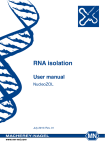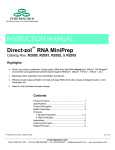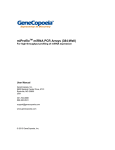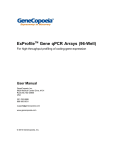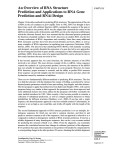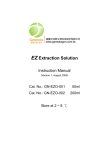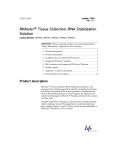Download RNAzol® RT RNA Isolation Reagent User Manual
Transcript
G e n e C o p o eia Expressway to Discovery TM RNAzol® RT RNA Isolation Reagent Most effective reagent for isolation of total RNA and small RNA from samples of various origin Cat. No. E01010A User Manual GeneCopoeia, Inc. 9620 Medical Center Drive, #101 Rockville, MD 20850 USA 301-762-0888 866-360-9531 [email protected] www.genecopoeia.com © 2013 GeneCopoeia, Inc. RNAzol® RT RNA Isolation Reagent User Manual USER MANUAL RNAzol® RT RNA Isolation Reagent I. Introduction II. Content and Storage III. Sample Preparation IV. Isolation of mRNA and microRNA Fractions V. Isolation of Total RNA VI. Notes and Troubleshooting VII. References VIII. Limited Use License and Warranty I. Introduction RNAzol®RT is the most effective reagent for isolation of total RNA and small RNA from samples of various origins, including human, animal, plant, bacterial and viral origin. RNAzol®RT separates RNA from other molecules in a single step based on the interaction of phenol and guanidine with cellular components. No chloroform-induced phase separation is necessary to obtain pure RNA. It isolates mRNA and microRNA in separate fractions. Alternatively, total RNA containing all classes of RNA in a single fraction can be isolated. In addition, the patented reagent allows for the sequential isolation of RNA and DNA. Advantages Higher yield and quality • Isolate pure and undegraded RNA that is ready for RT-PCR without DNase treatment • Provides higher yield and quality of isolated RNA than previous reagents Easy isolation of mRNA, microRNA or total RNA • Isolate mRNA and microRNA in separate fractions • Isolate total RNA in one fraction Fast and convenient • The isolation procedure can be completed in less than one hour • No chloroform-induced phase separation is necessary • Stable at room temperature for both storage and experimental procedure 2 RNAzol® RT RNA Isolation Reagent User Manual Protocol overview 1. Isolation of mRNA and micro RNA fractions Samples homogenization DNA/protein precipitation RNA Supernatant Supernatant Precipitation microRNA precipitation mRNA precipitation microRNA washes mRNA washes microRNA solubilization mRNA solubilization ------------------------------------Total < 1 hour 2. Isolation of total RNA Samples homogenization Total RNA Supernatant DNA/protein precipitation BAN purification (optional) Total RNA precipitation Total RNA washes Total RNA solubilization -----------------------------------Total < 1 hour 3 RNAzol® RT RNA Isolation Reagent User Manual II. Contents and Storage RNAzol® RT RNA Isolation Reagent (Cat. No. E01010A) Contents Amounts Shipping temperature RNAzol® RT RNA Isolation Reagent 50mL Room temperature Storage temperature Room temperature. Stable for at least two years from date of purchase. Important note: RNAzol®RT contains phenol (corrosive liquid/poison) and guanidine thiocyanate (irritant). CAUSES BURNS and can be fatal. When working with RNAzol®RT, use gloves and eye protection (face shield, safety goggles). Do not get on skin or clothing. Avoid breathing fumes. Read the warning note on the container and MSDS. In case of contact: Immediately flush eyes or skin with a large amount of water for at least 15 minutes and if necessary seek medical attention. Materials required but not supplied Ethanol Isopropanol 4-bromoanisole (BAN, optional) RNase-free water III. Sample Preparation 1. Homogenization A. Tissues. Homogenize tissue samples in a Polytron-type homogenizer or glass-teflon homogenizer using up to 100 mg of tissue per 1 ml of RNAzol®RT. When processing tissues with high DNA content such as spleen, use 50 mg of tissue/1 ml reagent. For clarity of presentation, the protocol describes isolation using 1 ml of RNAzol®RT. For the most practical/ economical processing of samples use 1.5 - 2 ml microcentrifuge tubes. For example, use a 0.88 ml aliquot(s) of the homogenate (0.88 ml = 0.8 ml reagent + 80 mg tissue) and freeze the rest of the homogenate for later use. The homogenate can be stored at -20 or -70 C for at least one year. B. Cells. Cells grown in monolayer should be lysed in the culture dish by addition of RNAzol®RT. Remove culture medium and add at least 1 ml of reagent per 3.5 cm culture 2 dish (10 cm ). Pass the lysate through a pipette several times to ensure lysis. Cells grown in suspension should be sedimented first and then lysed by the addition of 7 RNAzol®RT. Add at least 1 ml of RNAzol®RT per 10 cells and lyse cells by repeated pipetting. Washing cells before the addition of RNAzol®RT is not recommended as it may contribute to RNA degradation. For cells grown in monolayer, use the amount of RNAzol®RT based on the area of the culture dish and not on cell number. The use of an insufficient amount of RNAzol®RT will result in DNA contamination of the isolated RNA. C. Liquid Samples. Homogenize/lyse liquid samples using 1 ml of RNAzol®RT per up to 0.4 ml of a liquid sample. For processing a small volume sample, mix the sample with 1 ml of RNAzol®RT and supplement the mixture with water to approach the sample + water volume of 0.4 ml. D. Samples with fat content. Centrifuge homogenate of high-fat samples at 12,000 g for 5 min. After centrifugation, fat collects at the top of the tube. Pierce the fat layer with a pipette or syringe and transfer the supernatant into a new tube and process samples as described below. For better handling of samples, solidify the top fat layer by performing centrifugation at 4 10℃. 4 RNAzol® RT RNA Isolation Reagent User Manual 2. DNA, protein and polysaccharide precipitation 1) Add to the homogenate/lysate 0.4 ml of water per 1 ml of RNAzol®RT used for homogenization. 2) Shake the resulting mixture vigorously for 15 seconds and store it for 5 - 15 min. Samples with 100 mg tissue/ml RNAzol®RT require a 15 min storage at room temperature. 3) Next, centrifuge samples at 12,000 g for 15 min. Following centrifugation, DNA, proteins and most polysaccharides form a semisolid pellet at the bottom of the tube. The RNA remains soluble in the supernatant. Centrifugation at this and other steps of the protocol can be performed at 4 - 28℃. IⅤ. Isolation of mRNA and microRNA Fractions 1. Precipitation of mRNA fraction 1) Transfer 1 ml of the supernatant (75% of total supernatant volume) to a new tube, leaving a layer of the supernatant above the DNA/protein pellet. 2) Precipitate RNA by mixing the transferred 1 ml of supernatant with 0.4 ml of 75% ethanol (v/v). 3) Store samples for 10 min and centrifuge them at 12,000 g for 8 min. RNA precipitate forms a white pellet at the bottom of a tube. 4) Transfer the supernatant to a new tube and store it at 4℃ or at -20℃ for isolation of micro RNA. It is safe to collect up to 85% of the supernatant. The mRNA fraction contains RNA >200 bases including large nuclear RNA, all mRNA and ribosomal RNA. 2. Precipitation of micro RNA fraction 1) Mix the supernatant obtained after precipitation of RNA in Step 1 with 0.8 volume of isopropanol. Store the samples for 30 min at 4℃ 2) Sediment the precipitated RNA at 12,000 g for 15 min at 4 - 28℃. RNA precipitate forms a white pellet at the bottom of a tube. The micro RNA fraction contains RNA <200 bases including small ribosomal RNA, tRNA and micro RNA down to 10 bases. 3. RNA washes 1) Mix the mRNA (step 1) pellet with 75% ethanol (v/v) or the micro RNA pellet (Step 2) with 70% isopropanol (v/v). Centrifuge the pellets at 4,000 - 8,000 g for 1 - 3 min. 2) Repeat. When performing isolation in 1.5 ml microcentrifuge tubes, use 0.4 - 0.6 ml of the alcohol solution. For samples processed in larger tubes use 0.5 ml of alcohol solution per 1 ml of the supernatant used for precipitation. Remove the alcohol solution using a micropipette. 4. RNA solubilization 1) Dissolve the RNA pellet, without drying, in RNAse-free water to approach the RNA concentration of 1 - 2 µg/µl for the mRNA fraction and about 0.1 µg/µl for the microRNA fraction. 2) For solubilization in water, vortex the RNA pellet at room temperature for 2 - 5 min. Tubes and water used for the RNA solubilization should be RNase-free. Drying the RNA pellet is not recommended as this greatly decreases its solubility. Frequent vortexing is hard on hand joints and may lead to injury. Use vortex equipped with a platform with holes for tubes. The isolated mRNA fraction contains RNA >200 bases. This RNA fraction constitutes 80 85% of cellular RNA. Expected yields: A) tissues (µg RNA/mg tissue): liver, 5 - 7 µg; kidney, spleen, 3 - 4 µg; 6 skeletal muscle, brain, lung 0.5 - 1.5 µg; placenta, 1 - 3 µg: B) cells (µg RNA/10 cells): epithelial cells, 5 - 8 µg; fibroblasts, 3 - 5 µg. The isolated RNA has a 260/280 ratio of 1.8 to 2.1 and a 260/230 ratio of 1.8 to 2.3. The RIN value of RNA for tissue removed from an animal (or frozen in liquid nitrogen and stored at -70) and immediately processed is >9. 5 RNAzol® RT RNA Isolation Reagent User Manual The isolated micro RNA fraction contains RNA <200 bases. The isolated RNA has a 260/280 ratio of 1.6 - 1.7 and a 260/230 ratio of about 1.5. V. Isolation of Total RNA 1. Phase separation (optional step) This additional step is beneficial for samples with a high content of DNA and/or extracellular material. 1) Add 5 µl (0.5% of the supernatant volume) of 4-bromoanisole (MRC, BN 191) to 1ml of the transferred supernatant. 2) Shake the resulting mixture for 15 sec, store it for 3 - 5 min and centrifuge it at 12,000 g for 10 min at 4 - 25 C. 3) After centrifugation, residual DNA, proteins and polysaccharide precipitate accumulates in the organic phase at the bottom of a tube, while RNA remains soluble in the supernatant. 4-bromoanisole can not be substituted with bromochloropropane or chloroform. 2. Precipitation of total RNA 1) Transfer the RNA-containing supernatant to a new tube. Precipitate RNA by mixing 1ml of the supernatant with 1 ml of isopropanol. 2) Store samples for 10 min and centrifuge them at 12,000 g for 10 min. In most cases, RNA precipitate forms a white pellet at the bottom of a tube. In samples such as spleen, RNA accumulates as a gel-like membrane on the side of a tube. The membrane becomes more visible during washing with ethanol. 3. RNA washes 1) Wash the RNA by mixing the RNA pellet with 75% ethanol (v/v). Centrifuge the pellets at 4,000 - 8,000 g for 1 - 3 min. 2) Repeat. When performing isolation in 1.5 ml microcentrifuge tubes, use 0.4 - 0.6 ml of the ethanol solution. For samples processed in larger tubes, use 0.5 ml of alcohol solution per 1 ml of the supernatant used for precipitation. Remove the alcohol solution using a micropipette. 4. RNA solubilization 1) Dissolve the RNA pellet, without drying, in RNAse-free water to approach the RNA concentration of 1 - 2 µg/ml. 2) For solubilization in water, vortex the RNA pellet at room temperature for 2 - 5 min. Tubes and water used for the RNA solubilization should be RNase-free. Drying the RNA pellet is not recommended as this greatly decreases its solubility. Frequent vortexing is hard on hand joints and may lead to injury. Use a vortex equipped with a platform with holes for tubes. The isolated total RNA contains all classes of RNA including ribosomal RNA, mRNA and micro RNA down to 10 bases long. Expected yields: A) tissues (µg RNA/mg tissue): liver, 6 - 8 µg; kidney, spleen 3 - 4 µg; skeletal 6 muscle, brain, lung 0.5 - 1.5 µg; placenta, 1 - 3 µg: B) cells (µg RNA/10 cells): epithelial cells, 5 - 10 µg; fibroblasts, 4 - 6 µg. The isolated RNA has a 260/280 ratio of 1.7 to 2.1 and a 260/230 ratio of 1.6 to 2.3. The RIN value of RNA for tissue removed from an animal (or frozen in liquid nitrogen and stored at -70) and immediately processed is >9. VI. Notes and Troubleshooting Notes to the protocols 1. A rapid removal and immediate homogenization of tissues is critical for the integrity and yield of RNA. The most effective method is homogenization for 2 - 3 min in a Polytron-type homogenizer set at a high-speed. 6 RNAzol® RT RNA Isolation Reagent User Manual 1) 2) To further prevent RNA degradation in tissues with high level of RNase, perform homogenization in cold RNAzol®RT. The resulting homogenate can be stored/processed at room temperature. Brain samples require the use of a glass-Teflon homogenizer because of excessive foaming. 2. To estimate tissue weight used for the homogenization, place 1 - 5 ml of the reagent in a tube on a balance and tare it. Drop fresh or frozen tissue into the reagent, record the tissue weight and immediately homogenize the sample. After dispersing the tissue, supplement the homogenate with the reagent to achieve, for example, 80 mg tissue per ml of the reagent. 3. The RNA isolation can be interrupted and samples can be stored as indicated below: 1) The sample homogenate, before addition of water, can be stored overnight at 4 C or for at least one year at -20 C. To thaw the samples, incubate them at 37 - 40 C for 5 min. 2) The RNA precipitate can be stored in 75% ethanol overnight at room temperature (RNA wash), for at least one week at 4 C, or at least one year at -20 C. Troubleshooting guide Low yield. a) incomplete homogenization or lysis of samples; b) incomplete solubilization of the final RNA pellet. 260/280 ratio<1.6. a) insufficient volume of the reagent was used for homogenization; b) acidic water was used for the OD measurement; c) incomplete solubilization of the RNA pellet; d) proteoglycan or polysaccharide contamination. RNA degradation. a) tissues were not immediately processed or frozen in liquid nitrogen after removal from an animal; b) samples used for RNA isolation were stored at -20 C instead of at -70 C; c) cells were dispersed by trypsin digestion; d) aqueous solutions or tubes used for solubilization of RNA were not RNase-free. DNA contamination. a) too much tissue or cells were used for the volume of the reagent used for homogenization; b) samples used for RNA isolation contained organic solvents, strong buffers, salt or alkaline solution. The following modifications of the DNA precipitation (Step 2) will further reduce DNA contamination: 1) After addition of water (Step 2), extend the incubation time to 15 minutes before sedimentation. 2) After addition of water, sediment the precipitated DNA (Step 2) at 16,000 g. Fat, proteoglycan and polysaccharide contamination. Perform additional centrifugation (12,000 g x 10 min) to clarify the initial crude homogenate (Step 1) and/or the phase separation described in the Protocol for total RNA isolation, step 3. VII. References 1. Chomczynski P, Reagents and methods for isolation of purified RNA, US Patent# 7,794,932, International Patents Pending. 2. Chomczynski P, and Sacchi N (1987) Single step method of RNA isolation by acid guanidinium thiocyanate-phenol- chloroform extraction. Anal. Biochem. 162, 156 - 159. 3. Chomczynski P (1993) A reagent for the single-step simultaneous isolation of RNA, DNA and proteins from cell and tissue samples. Biotechniques 15, 532 - 537. 4. Wilfinger W, Mackey K and Chomczynski P (1997) Effect of pH and ionic strength on the spectrophotometric assessment of nucleic acid purity. Biotechniques 22, 474 - 481. 7 RNAzol® RT RNA Isolation Reagent User Manual VIII. Limited Use License and Warranty Limited use license Following terms and conditions apply to use of the RNAzol® RT RNA Isolation Reagent. If the terms and conditions are not acceptable, the Product in its entirety must be returned to GeneCopoeia within 5 calendar days. A limited End-User license is granted to the purchaser of the Product. The Product shall be used by the purchaser for internal research purposes only. The Product is expressly not designed, intended, or warranted for use in humans or for therapeutic or diagnostic use. The Product must not be resold, repackaged or modified for resale, or used to manufacture commercial products or deliver information obtained in service without prior written consent from GeneCopoeia. Use of any part of the Product constitutes acceptance of the above terms. Limited warranty GeneCopoeia warrants that the Product meets the specifications described in the accompanying Product Datasheet. If it is proven to the satisfaction of GeneCopoeia that the Product fails to meet these specifications, GeneCopoeia will replace the Product. In the event a replacement cannot be provided, GeneCopoeia will provide the purchaser with a refund. This limited warranty shall not extend to anyone other than the original purchaser of the Product. Notice of nonconforming products must be made to GeneCopoeia within 30 days of receipt of the Product. GeneCopoeia’s liability is expressly limited to replacement of Product or a refund limited to the actual purchase price. GeneCopoeia’s liability does not extend to any damages arising from use or improper use of the Product, or losses associated with the use of additional materials or reagents. This limited warranty is the sole and exclusive warranty. GeneCopoeia does not provide any other warranties of any kind, expressed or implied, including the merchantability or fitness of the Product for a particular purpose. GeneCopoeia is committed to providing our customers with high-quality products. If you should have any questions or concerns about any GeneCopoeia products, please contact us at 301-762-0888. © 2013 GeneCopoeia, Inc. For Research Use Only. © 2013 GeneCopoeia, Inc. RNAzol®RT is the registered trademark of Molecular Research Center, Inc. US Patent 7794932, Chinese Patent 200580017853.5. International Patent application is pending. RNAZ-061213 8








